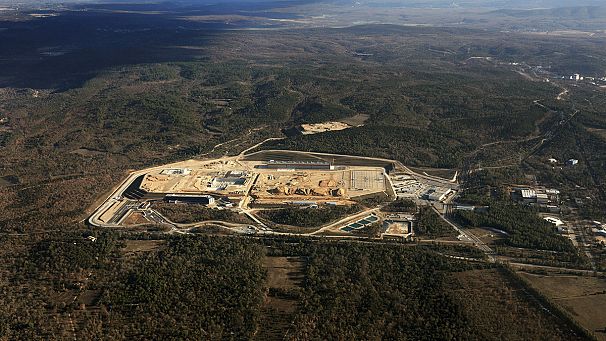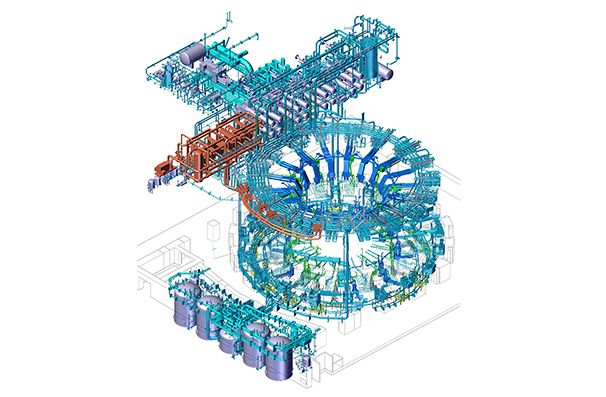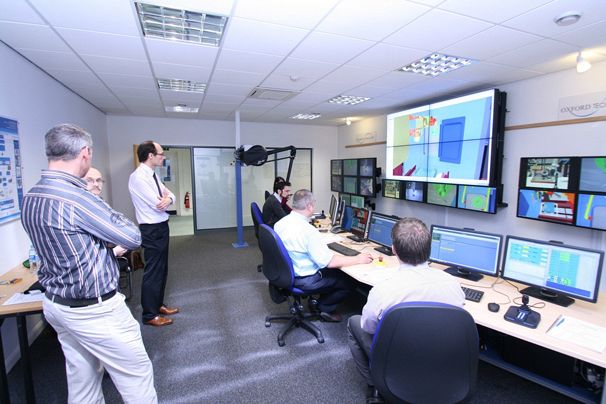Page added on April 5, 2014
ITER: How a new star will be born

The ITER project is truly at the frontier of knowledge, a collective effort to explore the tantalising future of free, clean and inexhaustible energy offered by nuclear fusion. Where the Large Hadron Collider at CERN pushes the boundaries of physics to find the origins of matter, the ITER project seeks to give humans an endless stream of power which could have potentially game-changing consequences for the entire planet. In this article, Robert Arnoux from ITER offers us his vision of nuclear fusion.

Opinion: A new star will soon be born, a star unlike any other … a man-made star. ITER— both the Latin word for “The Way” and the acronym of International Thermonuclear Experimental Reactor—will light up in the early years of the coming decade. From a scientific and technological point of view, it will be one of mankind’s major accomplishments. The creation of an artificial star and the tapping of the tremendous amounts of energy produced will forever alter the course of civilization.
The ITER project, a multibillion-euro international collaboration that brings together China, the European Union, India, Japan, Korea, Russia and the United States, is the culmination of 60 years of research and decades of diplomatic negotiation. It was the dream of three generations of physicists; it is now the reality of the hundreds of scientists, engineers and labourers gathered in southern France where the ITER installation is under construction.
The ITER machine is a tokamak, the Russian acronym for Toroidal Chamber, Magnetic Coils. Tokamaks were developed in the Soviet Union in the 1960s at a time when nations were experimenting with all kinds of different systems to reproduce the nuclear reactions at work in the core of the Sun and stars.
A tokamak, like a star, is designed to fuse light atoms into heavier ones. A tokamak is a magnificent tribute to Albert Einstein’s E=mc2: the tiny loss of mass that results from the fusion process translates into a huge quantity of energy. One gram of fusion fuel (the hydrogen isotopes deuterium and tritium) generates as much power as eight tons of oil.
ITER will be by far the largest and most complex tokamak ever built. Designed from the experience accumulated by hundreds of fusion machines throughout the world, it will demonstrate that fusion energy is scientifically and technologically feasible.
ITER will be the first tokamak to achieve a net production of fusion power, giving back ten times the energy invested to light the fusion fire—a crucial demonstration that would open the way to the industrial and commercial production of fusion-generated electricity.
To a world that craves ever greater amounts of electricity (global consumption will more than double by 2050), fusion energy offers an exceptionally attractive option: it is intrinsically safe; its environmental impact is low (no greenhouse-effect gases emitted or high-level, long-lived nuclear waste to manage) and the fuel supply is universally available and almost inexhaustible.
The ITER project was officially born at the Geneva Summit in November 1985 when Ronald Reagan and Mikhail Gorbachev agreed to launch an international effort to develop fusion energy “as an inexhaustible source of energy for the benefit of all mankind.”
As conflicts between nations most often arise over the control of energy sources, ITER was also meant as a project for peace.

The original ITER Members numbered four: the European Union (Euratom), Japan, the Soviet Union and the United States, joined by China and Korea in 2003 and by India in 2005. The ITER Organization, with the legal status of an international organization like CERN or the European Space Agency, was officially established in October 2007.
It took some twenty years to produce a design that would be scientifically, technologically and financially acceptable to all the ITER Members and four more years, beginning in the summer of 2001, to decide on the location where the machine would be built.
On 28 June 2005, the ITER Members unanimously agreed on the site proposed by Europe: a 180-hectare stretch of land adjacent to CEA-Cadarache, France’s largest nuclear research centre located in the Durance River Valley some 75 kilometres north of Marseille.
Preparation work on the ITER site began in January 2007. Over two years a 42-hectare platform was cleared, levelled and readied for the construction work that began in earnest in the summer of 2010.
Four years later, in the 17-metre-deep, 90 × 130 metre Seismic Pit that will house the ITER Tokamak and its main auxiliary buildings, 4,000 tons of steel rebar are being installed for the second basemat. This 1.5-metre-thick reinforced concrete “floor” will support the weight of 360,000 tons—more than the Empire State Building.
In other areas of the platform, new buildings are rising while others await tooling installation: the Assembly Hall, the Cryostat Workshop, the Coil Winding Facility are just a few among the 39 buildings that will eventually occupy the entire surface of the platform.
The intense activity on the ITER site is only one aspect of the project’s overall progression; ITER is also advancing in factories all over the world.
A unique aspect of the project’s architecture is the in-kind procurement system that was established at the onset of the project. Instead of contributing financial resources only to the ITER Organization, China, the European Union, India, Japan, Korea, Russia and the United States will be providing the machine components (and also buildings in Europe’s case).
While it adds considerable complexity to the overall management and realization of the project, the in-kind procurement process forms the core of ITER founding philosophy, offering the ITER Members invaluable experience in the building of a fusion installation. By contributing to the construction of the experimental machine ITER, they are creating the technological and industrial basis for the commercial fusion reactors of the future.
ITER Members have already launched preliminary studies for a next-step machine named DEMO—a steady-state tokamak that some consider an industrial prototype and others a “pre-industrial demonstrator.” It is as yet uncertain whether the DEMO project will be an international collaboration like ITER, or a succession of national ventures.
When will the world benefit from fusion-generated electricity supplied massively to the grid? Building on the ITER and DEMO demonstrations, the decision to launch a fusion industry will proceed from political choice. As one of the major figures in fusion research, the Russian physicist Lev Artsimovitch (1909-1973), used to say, “Fusion will be available when society needs it.”
It is more than likely that in the context of an exponential rise in electricity demand, fossil fuel depletion, the challenge of climate change and the issue of conventional nuclear energy acceptability, fusion will be needed in the second half of this century.
To make this choice possible, men and women from 35 nations have gathered on a sun-drenched portion of land, near the village of Saint-Paul-lez-Durance in the heart of Provence. In this magnificent setting, they are working hard to realize one of mankind’s most enduring dreams: capturing the fire of the Sun and making it available to humanity for the millennia to come.
-
UK
A dedicated remote handling control room to practice ITER maintenance

16 Comments on "ITER: How a new star will be born"


DC on Sat, 5th Apr 2014 1:00 am
Wow, fusion has been upgraded to ‘Free’ now, along with the old fusion perennials, ‘clean and inexhaustible’, according to Euronews. An endless stream of power awaits eh? Really? And even if such a lofty outcome was in the works(lol), what exactly would we do with ‘an endless stream of power’ anyhow? Weve had an endless stream of power since the early 20th century. I have an endless stream of power now at my disposal, all I have to do is keep paying my Hydro bill. What do I do with it? Keep up to date on the doings on the world on this computer and make tea and have hot showers-and other equally earth shattering things. Yes,it helped ‘us’ do some useful and nifty things, but it also enabled ‘us’ to commit great horrors and mistakes well be paying for hundreds if not thousands of years-or longer. Well, not a single one of the fusion tropes is remotely true, or accurate, but ‘free’ definitely takes the prize. However, as we well know, there are really no penalties or downside to printing utter falsehoods. Its little different than when guys like Yergin claim oil will $40.00 a barrel, or will last for centuries.
JJHMAN on Sat, 5th Apr 2014 1:41 am
I really don’t know if fusion will ever produce a single watt of useful energy or if it will enable us to live in a Star Trek future. But I actually worked on fusion energy in the early 1970’s and the story has gotten so old it seems to me more like Don Quixote than Captain Kirk.
It is interesting to me that this quest seems so comfortable to TPTB while there seems to be a constant nervousness about solar, wind and even conservation. That, I suspect, is more of the story than the relative technical viability of any particular choice: that is, if it provides the least disruption to the existing paradigm it will obtain the greatest support from those benefiting the most from the present.
dissident on Sat, 5th Apr 2014 2:04 am
Fusion research is like cancer research. A huge sink of money with little to show for it after decades. I will admit that reality may be a challenge to deal with and even small increments of progress could require vast effort and money. But I suspect the reality is more banal and we have people making careers rather than pushing the envelope.
It should also be noted that tokamak fusion is not something that occurs in nature. Stars have gravity overcoming coulomb repulsion and not super high temperatures. It is not at all clear that tokamak fusion is realizable.
ghung on Sat, 5th Apr 2014 3:55 am
A bridge too far. A bridge to nowhere. Children playing with fire…. I could go on, but it isn’t our technology that’s deficient.
Nony on Sat, 5th Apr 2014 4:33 am
ITER is not just a tricky and very expensive demonstration of something (but not commercial power). It’s actually a very screwed up project JUST IN EXECUTION.
Read up on the history and management of this thing. It’s got 15 countries doing different parts and pulling in different ways. Design is not centralized and coordinated. It’s been a disaster and a waste of billions.
Pull the plug. Not even because you’re skeptical of fusion research. It’s just not even a well administered program of any sort.
Jesper on Sat, 5th Apr 2014 5:56 am
ITER is like CERN. It’s Physics research. Current Nuclear plants are expensive – in the order of $8B. But this will be considered a bargain compared to a fusion plant.
Not even by a far stretch would a Fusion reactor ever come even close to being cheap enough to make economic sense.
Arthur on Sat, 5th Apr 2014 7:01 am
It is difficult to decide what would be a greater nightmare vision: 0-10 or 1000 virtual energy slaves per capita. If ITER succeeds, the latter scenario would become reality. Mobility would be unrestricted, at least from a technical and economical standpoint.
ITER is proven technology, or rather the only technology I am aware off that needs to be proven that it can be scaled downwards. Hope it fails, no guarantees though. Fusion is the technology of globilization pur sang. I prefer this counter vision:
http://youtu.be/w4m8HAuQyi8
Stilgar Wilcox on Sat, 5th Apr 2014 7:57 am
“It is more than likely that in the context of an exponential rise in electricity demand, fossil fuel depletion, the challenge of climate change and the issue of conventional nuclear energy acceptability, fusion will be needed in the second half of this century.”
If their figuring the next 36 years is a period of time to get fusion down pat, then I’d ask them to think again. The net energy decline is already having a huge impact on OECD central bank policies, printing, tossing more money into the system all the time to keep it floating. But expecting that to work for another 36 years is really wishful thinking.
And that’s not even delving into AGW, in which we could have runaway GW initiate not long after the Arctic begins having ice free summers because of the loss of albedo (reflectivity of incoming energy).
Beery on Sat, 5th Apr 2014 10:19 am
What we should be doing is taking more efficient advantage of the massive fusion reactor we already have at our disposal a mere 93 million miles away. Trying to create a tiny copy of it here on Earth is a huge waste of time and energy.
GregT on Sat, 5th Apr 2014 10:56 am
What Beery said.
Davy, Hermann, MO on Sat, 5th Apr 2014 11:16 am
ditto Berry
peakyeast on Sat, 5th Apr 2014 12:47 pm
“It should also be noted that tokamak fusion is not something that occurs in nature. Stars have gravity overcoming coulomb repulsion and not super high temperatures. It is not at all clear that tokamak fusion is realizable.”
Careful now – dont give them good ideas – they might just try creating a black hole in desperation or something like that..
I heard that the scientist during the manhattan project discussed that there was a chance albeit low that the nuclear bomb would ignite the atmosphere – they exploded the bomb anyway.
Taking chances like that should warrent extinction of everyone involved and those that revolved around it and those related to any such decision and project.
Meld on Sat, 5th Apr 2014 2:24 pm
Is it just me or do the same articles with different titles and containing words just keep cycling round again and again and again and again. Next it will be a peak oil is here article, then a peak oil is rubbish article because of malthus , then it’s a fusion article, then a solar article, then a peak food/water article, then a peak oil is here article …. etc. etc. etc. etc. What a fucking waste of life this all is Goodbye!
Arthur on Sat, 5th Apr 2014 2:53 pm
As I wrote a few days ago, Meld suffers from a TOD syndrome. No, there is not going to be a sudden supply collapse indeed (short of war), as many thought it would only 2 years ago, including me. That’s why TOD went belly up. All dressed up, but nowhere to go. Nevertheless, energy is going to be more central, can be taken less for granted with every passing year. The receipy for an energy forum to escape the fate of TOD is to ‘diversify’ the subject scope beyond mere barrel bean counting, and include topics as geopolitics, finance, technology and others.
Absolutely no need to close this forum down.
Norm on Sun, 6th Apr 2014 3:41 am
Go go Home Depot. Buy a five horsepower generator. Pull the rope start it up. Now you can do something that these clowns can never do: Power a kitchen toaster, with two slices Wonder
bread in it.
Jimmy on Mon, 7th Apr 2014 3:41 pm
That construction and engineering project doesn’t look free to me. I assume then that it’s all being run by donations and volunteers lol